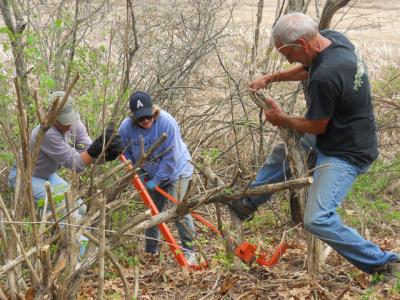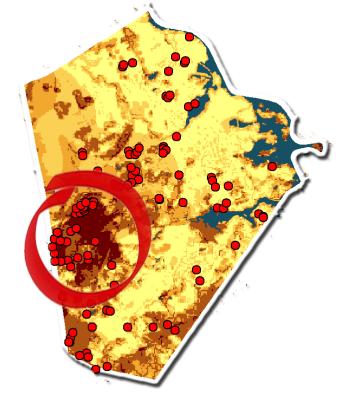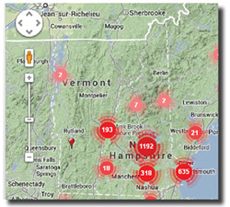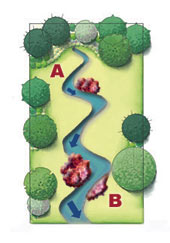Picking Our Battles
Planning Successful Invasive Plant Management Projects
 Invasive plants can cause significant ecological and economic harm and are changing the face of America. They may impact wildlife by choking out natural habitats such as freshwater wetlands, causing loss of available food, or by altering habitat structure or function.
Invasive plants can cause significant ecological and economic harm and are changing the face of America. They may impact wildlife by choking out natural habitats such as freshwater wetlands, causing loss of available food, or by altering habitat structure or function.
The importance of minimizing the spread of invasive plants across the landscape means they are a common focus of restoration projects. However, invasive plants know no boundaries and can easily reestablish from surrounding areas unless a landscape-scale strategic approach is taken to prioritizing management projects.
The New Hampshire Fish and Game Department, NH Natural Heritage Bureau, and Great Bay National Estuarine Research Reserve teamed up with over 120 community members, natural resource managers and academics to develop a statewide strategic prioritization plan for the control of upland, wetland, and intertidal invasive plant species.
Only by working together on shared invasive plant “battles” across differing land ownerships and political boundaries, can we effectively protect our native plants and wildlife habitat in the long term.
The New Hampshire invasive plant prioritization map shows “hot spots” that are good places to start looking for invasive plants. Once you have an idea of what is present, the maps can also help you decide the most effective place to start tackling invasive plants. The following are examples from New Hampshire communities using real world mapping information.
Meredith: Keep “Hot Spots” For Invasive Plant Control Uninfested
 A rapid assessment roadside survey was completed in Meredith in 2008. The town teamed with the NH Department of Agriculture’s Invasive Species Coordinator to collect invasive plant data visible while driving by in a car. It took just a week to record the location of over one thousand invasive plant populations.
A rapid assessment roadside survey was completed in Meredith in 2008. The town teamed with the NH Department of Agriculture’s Invasive Species Coordinator to collect invasive plant data visible while driving by in a car. It took just a week to record the location of over one thousand invasive plant populations.
The Priority Areas for Invasive Plant Management Map identifies three large “hot spots” for management, the interiors of which are without any known invasive populations. A good next step would be to try and explore these areas by foot to see if they really are free of invasive plants, or if there were just no populations visible from the road. If these “hot spots” truly are invasive free, then starting to manage the populations at their edge would be a good place to begin and would help keep these important areas invasive plant free.
Newmarket and Durham: Start Work in the Largest "Hot Spots"
In 2005 and 2006, the NH Fish and Game Department and Great Bay National Estuarine Research Reserve staff teamed with conservation organizations and private land owners to map invasive plants throughout a 3,000 acre watershed that spans the border of Newmarket and Durham. They managed to survey 92 percent of the entire watershed and identified over 1,500 invasive plant populations. Deciding where to start management could quickly become overwhelming. Fortunately, the Priority Areas for Invasive Plant Management Maps can help decipher where to start work in a well thought out way, even in heavily impacted areas. In this example, there are several “hot spots” where invasive plant management would be particularly effective, but two of these are especially large so removal in these areas would be a good place to start.
Portsmouth: Keep Major Infestations From Spreading
 In 2009, Portsmouth hired an ecological consulting company to complete an assessment of undeveloped properties within the city. Invasive plant information was collected using a simple data sheet and hand-held GPS. No information was recorded about the extent or density of any population.
In 2009, Portsmouth hired an ecological consulting company to complete an assessment of undeveloped properties within the city. Invasive plant information was collected using a simple data sheet and hand-held GPS. No information was recorded about the extent or density of any population.
Although darker areas on the Priority Areas for Invasive Plant Management Maps are usually the best starting point for management, in Portsmouth’s case it was found that one of the largest “hot spots” for management was heavily impacted with invasive plants. In this area the density of invasives is so great it is likely to be impossible to eradicate them throughout its extent. It would certainly take thousands of dollars and many years to make any significant impact. A clear strategy would be to focus on “spot fires” that prevent new populations from this major source spreading to surrounding areas.
There are several ways to approach invasive plant management that will help lead to a more successful project. Most depend on the location of your site and distribution of invasive plants present, but consideration of plant species ecology and management difficulty is also important.
Early Detection and Rapid Response
 Early detection and rapid response to prevent, or slow, a new invasive species coming into an area is the single most important strategy when planning invasive plant management projects. It is much easier to remove a few plants of an “early detection species” to stop it becoming established than to tackle a species that has firmly taken root throughout an area.
Early detection and rapid response to prevent, or slow, a new invasive species coming into an area is the single most important strategy when planning invasive plant management projects. It is much easier to remove a few plants of an “early detection species” to stop it becoming established than to tackle a species that has firmly taken root throughout an area.
Early detection and rapid response can take place within any sized area you select. You could choose a local watershed, town forest, parcel of conservation land, Wildlife Refuge, or even a single flower bed within your own backyard.
Prioritize Areas of Disturbance
Invasive plants are early colonizers of disturbed soils, so being proactive and trying to manage populations before a timber harvest, construction project, or other disturbance takes place can be a very effective strategy.
A timber harvest exposes the forest floor to additional light so any seeds present are likely to grow vigorously. As construction machinery moves soil around a site, seeds and fragments of invasive plant can be moved to previously uninfested parts of the property. Machinery can be the source for invasive plant populations starting in completely new areas if not washed thoroughly before leaving a site.
Disturbance can have natural as well as human-related origins. Floodplain forests are particularly subject to infestation by invasive plants as flood events can wash seeds and stem fragments from upstream banks and carry them to into these adjacent areas.
Protect Healthy Habitats First
Selecting habitats of priority within your project area is a good place to start targeting invasive plant management efforts. It could be a habitat relatively uncommon in New Hampshire, for example pine barrens or salt marshes, or it could be an area you are particularly fond of, such as the wetlands or a meadow on your property.
The NH Natural Heritage Bureau maintains an online list of exemplary natural communities for each municipality, along with rare plants and animals. They advise prioritizing areas that support globally rare natural communities or species, followed by high quality examples of common communities and state rare plants and animals, and finally areas that are particularly rich in biodiversity.
 Start at Headwaters and Work Downstream
Start at Headwaters and Work Downstream
Starting at the headwaters prevents reinfestation from upstream populations of the same species. This is particularly true in areas that are prone to flooding and high bank erosion. This is just as important a strategy for a major river such as the Androscoggin, Connecticut, Merrimack, or Saco as it is for a small order stream that drains from a local beaver impoundment.
Start with Small Populations First
In an area that has multiple sized populations of invasive plants, it often makes sense to start with the smallest first. The smaller a population, usually the less effort is needed for eradication. Early removal also prevents its growth into a large population that is more challenging, and costly, to tackle.
In some cases, an invasive plant population may be expansive and too challenging to control with the resources currently available. In this situation, it makes sense to draw a ring around the core infestation and focus on managing newly establishing populations, often called spot fires, at the periphery until resources are available to tackle the core patch fully over a committed number of years. When you do decide to tackle an extensive population, start on the outside of a large stand and work in towards the middle.
Proximity to Other Populations
Invasive plant management commonly takes place on a property of single ownership. However, it is important to be aware of populations of the same species on surrounding properties that may be close enough to reinfest a successful invasive plant management project on your land. If such populations exist, consider reaching out to the neighboring owner(s) and see if they are interested in beginning management on their property too. This will allow effective invasive plant control on your land to remain sustainable for a much longer period.
 Plant Distribution Pattern
Plant Distribution Pattern
An invasive plant species that is distributed throughout a large area will take much more time to get to than one that is densely clumped together. This will increase the volunteer time needed to complete a project and is a substantial part of the cost when hiring a commercial applicator. For this reason it may make sense to start with the clumped species first.
Species Ecology and Management Difficulty
An invasive plants’ seed bank duration, mechanism of spread to new areas, germination success, and shade tolerance are some of the key factors that combine to determine how difficult it will be to tackle successfully. Depending on the invasive plant species present within the project area you select, you may choose to focus first on species that are easiest to control.
For example, invasive bush honeysuckles produce seeds prolifically, but these remain viable only for a short time. In contrast, garlic mustard seeds can sprout for up to 10 years, so having a plan to keep checking back for a decade is the only way to be sure any population has been eradicated for good.



